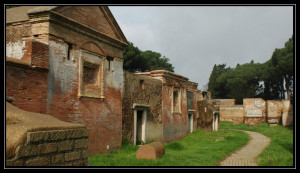
LISTEN TO THE AUDIO GUIDE:
The necropolis, came to light in 1925, consists of a set of very well-preserved tombs because buried by sand. The inscriptions and reliefs in terracotta on the facades of the places indicate niches of the dead crafts: artisans, shopkeepers, merchants, sailors, near port-related activities. A few hundred meters you will find the basilica of St. Hippolytus dating from the late 4th century a.d. by a substantial core of early Christian settlement in the area.
Alberto Angela tells us during an episode of SuperQuark the beautiful necropolis of Porto
 In antiquity the area was crossed by a major dual carriageway, Flavia, 10 meters wide, which ran parallel to the nearby coast, connecting Porto with Ostia. Along the sides of the road had the tombs in which were buried between the middle of the 2nd and beginning of the 4th century, the inhabitants of Porto, mainly sailors and workers engaged in port services.
In antiquity the area was crossed by a major dual carriageway, Flavia, 10 meters wide, which ran parallel to the nearby coast, connecting Porto with Ostia. Along the sides of the road had the tombs in which were buried between the middle of the 2nd and beginning of the 4th century, the inhabitants of Porto, mainly sailors and workers engaged in port services.
A necropolis, so devoid of monuments especially rich, but very interesting for understanding of ordinary people.
Not all of the tombs have been excavated and many still lie under the blanket of sand that has preserved from the ravages of time and the raids of barbarians and pirates. Mostly resemble houses built in masonry, with or without cell fence, leaning against each other and aligned along the road on several fronts, by invoking the "insulae" in Ostia Antica. Intended for whole families, thereby not only to owners but also to their Freedmen and their descendants within niches and newsstands for the ashes, often handled by pediments and apses, reminiscent of the "frontes stage" theatre and the architecture of the nymphs.
To the left of the entrance to the necropolis is a small pyramid-shaped tomb of the painter Sunny penthouse, originally from Gallia and died in 36 years.
Very interesting is the presence of numerous inscriptions placed above the entrance doors, where shows, in addition to the names of the dead, some important information on crafts and social placement.
Particularly impressive are the scenes in which the deceased are shown at work: a midwife assisting at childbirth, a surgeon in place to operate, a blacksmith and a hardware store, a grain merchant, etc.
One sees a surgeon on a stool in front of a patient, also sitting, to which perhaps are performing a bloodletting, a practice widespread in ancient medicine as a cure to the most different diseases. On the right there is a pad housing with surgical instruments, including scalpels in various forms.

It is famous for the terracotta slab with the mother-naked sitting on the sedia gestatoria, assisted by a midwife and a standing woman passes the arms under the armpits. Then there is the relief with a man dressed in a short tunic, a blacksmith, probably before his worktable and one with a water seller or manufacturer of amphora depicted with his left hand holding a large container. Also featured are menial jobs, like the cobbler or Roper.
In a workshop of marble workers cut, workers are working and carrying large stones.

A strong symbolism pervades the mosaic in front of the Tomb, 43 in which two ships in full sail, with two boats in tow, heading a four-story lighthouse, with a nice fire on top.
It is the lighthouse of port, to which the owner of the Tomb, perhaps a shipowner, looked at many times with confidence at the end of a long and dangerous journey. At the same time, the Greek inscription ' pausylypos ode ", here is the end of the troubles, remind the passer-by that death for humans, as the port for ships, is the safe harbor that frees us from the evils of the world.
L’Area archeologica apre al pubblico con il seguente orario:
dalle ore 10:30 alle ore 16:30 dal martedì alla domenica
The site is closed on 1° gennaio and the 1° maggio, the 25 dicembre, the 26 dicembre, tutto il mese di agosto.
Il sito è raggiungibile percorrendo via dell’Aeroporto di Fiumicino sino a Via Cima Cristallo e poi Via Pal Piccolo, fino a via Monte Spinoncia 52.
Tickets
Intero: 6 euro
Ridotto: 2 euro (per i giovani dell’Unione Europea dai 18 ai 25 anni)
Per informazioni: tel. 06 6583888 – 06/56358099 (centralino)
The staff provides supervision and guidance to the public reception.
Per informazioni: tel. 06 6583888 – 06/56358099 (centralino)
The staff provides supervision and guidance to the public reception.
More information: http://archeoroma.beniculturali.it/siti-archeologici/ostia/necropoli-porto